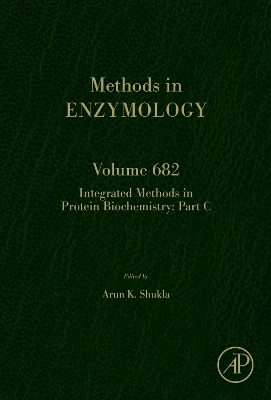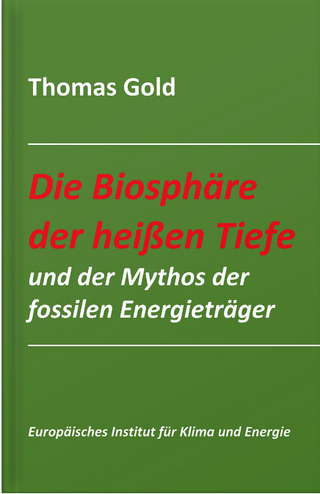
Integrated Methods in Protein Biochemistry: Part C
Academic Press Inc (Verlag)
978-0-443-18592-2 (ISBN)
Other sections cover Covalent protein painting: MS-based protein footprinting, Characterization of GPCR signaling complexes using negative-staining electron microscopy, Probing protein misfolding and dissociation with free electron laser, Optimized protocol for the characterization of Cas12a activities, Proximity proteomics for the identification and characterization of extracellular vesicles, Functional characterization of lytic polysaccharide monooxygenases (LPMOs), Characterization of RRE domain in RiPP biosynthesis, The Preparation of Recombinant Arginyltransferase 1 (ATE1) for Structural and Biophyiscal Characterizations, Testing anti-cancer drugs with Holographic Incoherent-light-source Quantitative Phase Imaging, and more.
Dr. Arun K. Shukla is a world leader in the field of GPCR biology and he is currently a Professor in the Department of Biological Sciences and Bioengineering at the Institute of Technology, Kanpur in India. Dr. Shukla’s research program is focused on understanding the structure, function and regulation of G protein-coupled receptors with a long-term of designing novel therapeutics with minimized side-effects.
1. NanoBiT-based methods to monitor the activation and modulation of RTKs
2. The interplay of G-protein ß? subunit and PLC-ß enzyme in PIP2 hydrolysis and downstream signaling
3. Biochemical Analysis of Protein-Protein Interfaces underlying the regulation of Bacterial Secretion Systems
4. Probing the structure and function of N-acetylmannosamine-6-phosphate 2-epimerase
5. Spectroscopic analysis of cysteine dioxygenase: a mammalian thiol-dioxygenase
6. DeGlyPHER: MS-based analysis of viral spike N-glycoforms
7. Covalent protein painting: MS-based protein footprinting
8. Characterization of GPCR signaling complexes using negative-staining electron microscopy
9. Probing protein misfolding and dissociation with free electron laser
10. Optimized protocol for the characterization of Cas12a activities
11. Proximity proteomics for the identification and characterization of extracellular vesicles
12. Functional characterization of lytic polysaccharide monooxygenases (LPMOs)
13. Characterization of RRE domain in RiPP biosynthesis
14. The Preparation of Recombinant Arginyltransferase 1 (ATE1) for Structural and Biophyiscal Characterizations
15. Testing anti-cancer drugs with Holographic Incoherent-light-source Quantitative Phase Imaging
16. Gel-based sample preparation methods for top-down native/cross-linking mass spectrometry
17. Identification and characterization of natural products and their interacts with anti-mycobacterial drug target proteins
18. Quantitative cysteinome profiling with DIA-ABPP
19. High-throughput screening and evolution of carbohydrate-active enzymes
20. Regulation of enzymes with light using unnatural amino acids
21. An optimized protocol for modular cloning to rapidly assemble expression vectors for MS-based orthogonal interactomics studies
22. Nucleotide-linked resins to identify new nucleotide-binding proteins using proteomics
23. Phospho-proteomic analysis of immune cells expressing chimeric antigen receptors
24. Novel strategies for targeting ubiquitin conjugation machinery using synthetic molecules
25. Reconstitution of the MLL1 complex and probing methyltransferase activity
26. Probing cellular aspects of endocytosis and phagocytosis with super-resolution microscopy
27. Structural and functional analysis of mono-copper enzymes from fungal species
28. Structure, function and regulation of deubiquitinases and RNA-modifying proteins.
29. Electrophysiology of ion-transporting rhodopsins
30. Measuring protein post-translational modifications using the protein semi-synthesis
31. Assay design and analysis of human Uracil DNA Glycosylase (UNG2)
32. Structure and function of T-Cell Protein Tyrosine Phosphatase (TCPTP)
33. Gel-based sample preparation methods for top-down/native/cross-linking mass spectrometry
34. Global substrate profiling of post-translational modifying enzymes
35. Methods for measuring kinetic isotope effects on the hydroxylation of a peptide
| Erscheinungsdatum | 27.03.2023 |
|---|---|
| Reihe/Serie | Methods in Enzymology |
| Verlagsort | San Diego |
| Sprache | englisch |
| Maße | 152 x 229 mm |
| Gewicht | 930 g |
| Themenwelt | Naturwissenschaften ► Biologie ► Biochemie |
| Naturwissenschaften ► Biologie ► Genetik / Molekularbiologie | |
| ISBN-10 | 0-443-18592-1 / 0443185921 |
| ISBN-13 | 978-0-443-18592-2 / 9780443185922 |
| Zustand | Neuware |
| Informationen gemäß Produktsicherheitsverordnung (GPSR) | |
| Haben Sie eine Frage zum Produkt? |
aus dem Bereich


